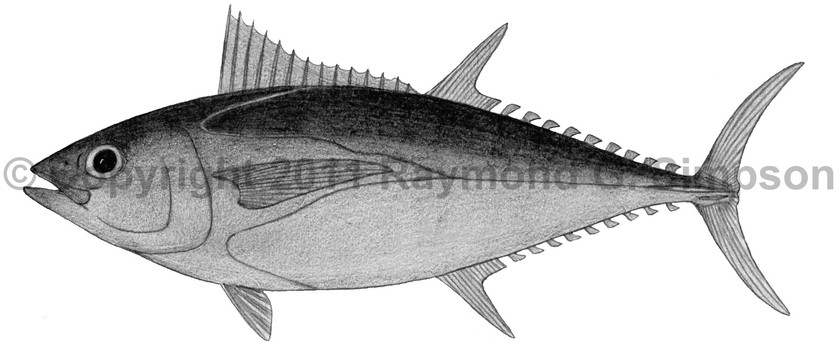
Common Name
Bigeye Tuna
Year Described
Lowe, 1839
Identification
Dorsal Fin: XI-XIV, 12-16, followed by 8-10 finlets
Anal Fin: 11-16, followed by 7-10 finlets
Pectoral Fin: 30-36
Gill Rakers: 23-31 (on first arch)
Vertebrae: 39
Body fusiform, robust, and oval in cross-section. Snout about twice eye diameter. Adipose eyelid absent. Jaw extends to anterior half of orbit. Teeth small and conical. Two interpelvic processes; shorter than pelvic fins. Dorsal fins separated by a very small gap. Spiny dorsal fin long, with a strongly concave margin. Second dorsal and anal fin small with tall anterior lobes. Pectoral fins long in adults (to second dorsal origin), but extremely long (reaching well beyond second dorsal fin) in young fish. Caudal fin semilunate. Corselet not obvious but present. Body covered in very small scales. Two small caudal keels with a larger median keel in between them. Liver striated; central lobe longest.
Color
Body white with an abruptly dark blue back. A blue sheen present on the dorsum of fresh specimens. The dorsal and anal fins/finlets are dusky yellow. The caudal fin is dusky to dark.
Size
Maximum size to 250cm FL. Common to 180cm FL.
Habitat
Epipelagic and mesopelagic in oceanic waters. Forms schools.
Range
Nova Scotia to S. Brazil, including the Gulf of Mexico and the Caribbean Sea.
References
Collette, B.B. 2002. Scombridae (pp 1836-1857). In: Carpenter. 2002. The living marine resources of the Western Central Atlantic. Vol. 3: Bony fishes part 2 (Opistognathidae to Molidae), sea turtles and sea mammals. FAO Species Identification Guides for Fisheries Purposes. American Society of Ichthyologists and Herpetologists Special Publication No. 5.
McEachran, J.D. and J.D. Fechhelm. 2005. Fishes of the Gulf of Mexico. Volume 2: Scorpaeniformes to Tetraodontiformes. University of Texas Press, Austin. i-viii +1-1004.